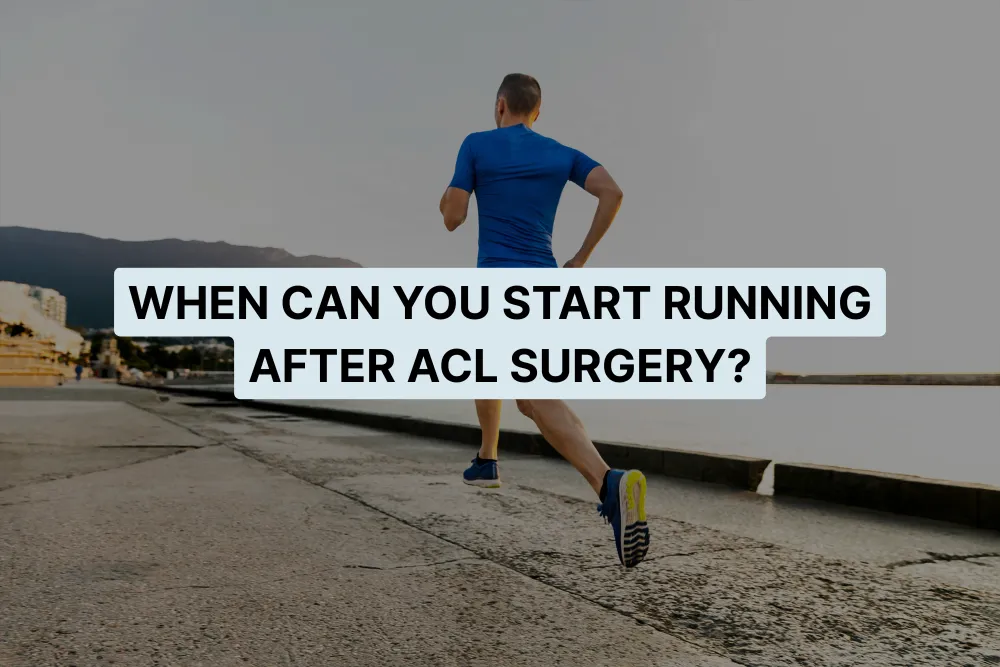For many patients going through post-surgery rehab after ACL reconstruction, the idea of running again represents a major milestone. Whether you’re an athlete or just someone who enjoys staying active, getting back to running is a common and emotional goal.
But here’s the truth: running too soon can put your recovery at risk. As physiotherapists, our job is to guide you through a safe, evidence-based progression that protects your knee and sets you up for long-term success.
Understanding ACL Recovery: It’s Not Just About Time
ACL surgery is just the beginning of a much longer journey. After the graft (often taken from your patellar tendon, hamstring, or quadriceps) is placed, the body needs time to heal, remodel, and reintegrate that tissue. But healing isn’t just biological, it’s also functional.
You need to:
- Regain full range of motion
- Rebuild strength, especially in the quadriceps and hamstrings
- Retrain balance and neuromuscular control
- Relearn movement patterns like walking, hopping, and eventually running
So while you may hear that most people return to running at 3 to 6 months. It’s not just about the calendar, it’s about meeting specific clinical criteria.
General Timeline: When Can You Run After ACL Surgery?
| Post-Op Phase | Goals | Running Status |
|---|---|---|
| 0–6 weeks | Control pain, reduce swelling, regain knee range, normalize walking | 🚫 No running |
| 6–12 weeks | Build muscle strength and balance | 🚫 No running yet |
| 3–4 months | Prepare body for impact, begin hopping, introduce light plyometrics | ⚠️ May start jogging if cleared |
| 4–6 months | Start low-impact running on flat surfaces under supervision | ✅ Begin running progression |
| 6–9+ months | Advance to cutting, agility drills, and sport-specific movements | ✅ Gradual return to sport |
| 9–12 months | Full sports participation if all return-to-sport tests are passed | ✅ Return to competition (if ready) |
Criteria to Meet Before Running
Running has a high impact, even if it doesn’t involve sudden cutting or pivoting. Before we clear you to start, you must meet specific objective milestones, such as:
- Full knee range of motion
- Minimal or no pain/swelling
- Quadriceps and hamstring strength at least 70–80% of the non-injured leg
- Good dynamic balance and control (tested through single-leg tasks like hopping or step-downs)
- Stable, symmetrical gait pattern
You may also undergo a running readiness assessment, which includes video gait analysis, hop tests, and strength measurements.
Common Mistakes to Avoid
We often see patients eager to run again make these errors:
- Going by time, not by readiness
- Ignoring signs of inflammation or instability
- Skipping strength work (especially quadriceps)
- Comparing recovery with others
- Relying on self-assessment instead of professional clearance
The Role of Physiotherapy in Your Return to Running
Your sports physiotherapist plays a vital role in your safe return to running. Here’s what we typically do:
- Assess readiness using clinical tests
- Design a graduated return-to-run plan, starting with walk/jog intervals
- Monitor your form, especially for compensation patterns or overloading
- Progress you safely to harder surfaces, longer durations, and eventually agility and sprint drills
We also guide your mental readiness because the fear of re-injury is real, and rebuilding confidence is just as important as rebuilding strength.
Does Running Mean You’re Ready for Sports?
Not quite.
Running is a big step, but returning to high-level sports like football, basketball, or tennis requires further testing and training. Most athletes are cleared for full competition between 9–12 months post-op.
Why? Because sports involve more than just straight-line running. They include cutting, pivoting, jumping, quick stops, and unpredictable movements. These dynamic actions place much higher stress on your knee and ACL graft.
That’s why physiotherapists and sports medicine teams use a series of objective, evidence-based tests before clearing athletes to return to sport. The tests include:
- Hop tests (distance, time, control)
- Agility and cutting assessments
- Psychological readiness screening
- Strength symmetry ≥ 90% of the uninjured side
Research shows that athletes who return to sport without proper testing and clearance are up to four times more likely to suffer a second ACL injury (Kyritsis et al., 2016).
Final Thoughts
Running again after ACL surgery is a major win but only when your body is truly ready. Don’t rush the process. With expert physiotherapy guidance, consistent rehab, and objective milestones, you can return to running safely and confidently.
Ready to Get Back on Track?
If you’re recovering from ACL surgery and looking for a structured post-surgery rehab plan, Physioveda offers advanced sports injury treatment and return-to-run testing guided by licensed physiotherapists.

Amit Saraswat is the Founder of Physioveda Medical Center, a Dubai-based clinic focused on personalized physiotherapy and integrative healthcare. With a passion for patient-centric solutions, he leads the vision behind Physioveda’s evidence-based approach to pain relief and long-term recovery.

